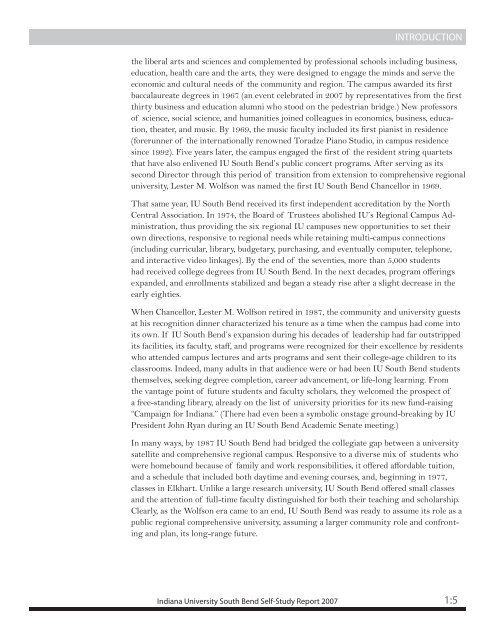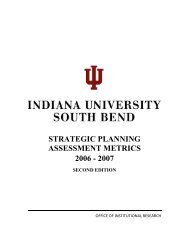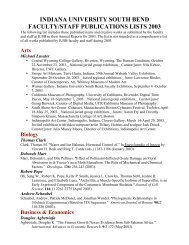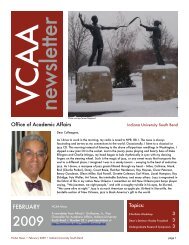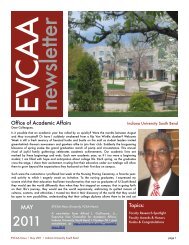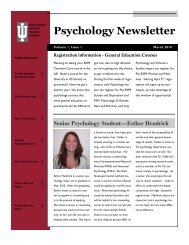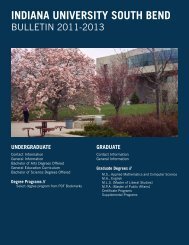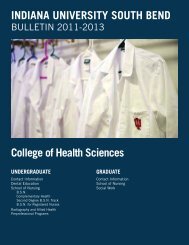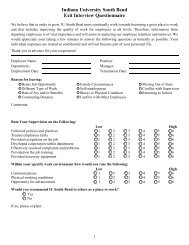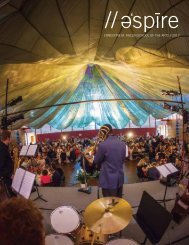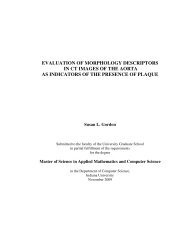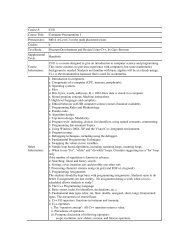HLC Self-Study - Indiana University South Bend
HLC Self-Study - Indiana University South Bend
HLC Self-Study - Indiana University South Bend
You also want an ePaper? Increase the reach of your titles
YUMPU automatically turns print PDFs into web optimized ePapers that Google loves.
INTRODUCTION<br />
the liberal arts and sciences and complemented by professional schools including business,<br />
education, health care and the arts, they were designed to engage the minds and serve the<br />
economic and cultural needs of the community and region. The campus awarded its first<br />
baccalaureate degrees in 1967 (an event celebrated in 2007 by representatives from the first<br />
thirty business and education alumni who stood on the pedestrian bridge.) New professors<br />
of science, social science, and humanities joined colleagues in economics, business, education,<br />
theater, and music. By 1969, the music faculty included its first pianist in residence<br />
(forerunner of the internationally renowned Toradze Piano Studio, in campus residence<br />
since 1992). Five years later, the campus engaged the first of the resident string quartets<br />
that have also enlivened IU <strong>South</strong> <strong>Bend</strong>’s public concert programs. After serving as its<br />
second Director through this period of transition from extension to comprehensive regional<br />
university, Lester M. Wolfson was named the first IU <strong>South</strong> <strong>Bend</strong> Chancellor in 1969.<br />
That same year, IU <strong>South</strong> <strong>Bend</strong> received its first independent accreditation by the North<br />
Central Association. In 1974, the Board of Trustees abolished IU’s Regional Campus Administration,<br />
thus providing the six regional IU campuses new opportunities to set their<br />
own directions, responsive to regional needs while retaining multi-campus connections<br />
(including curricular, library, budgetary, purchasing, and eventually computer, telephone,<br />
and interactive video linkages). By the end of the seventies, more than 5,000 students<br />
had received college degrees from IU <strong>South</strong> <strong>Bend</strong>. In the next decades, program offerings<br />
expanded, and enrollments stabilized and began a steady rise after a slight decrease in the<br />
early eighties.<br />
When Chancellor, Lester M. Wolfson retired in 1987, the community and university guests<br />
at his recognition dinner characterized his tenure as a time when the campus had come into<br />
its own. If IU <strong>South</strong> <strong>Bend</strong>’s expansion during his decades of leadership had far outstripped<br />
its facilities, its faculty, staff, and programs were recognized for their excellence by residents<br />
who attended campus lectures and arts programs and sent their college-age children to its<br />
classrooms. Indeed, many adults in that audience were or had been IU <strong>South</strong> <strong>Bend</strong> students<br />
themselves, seeking degree completion, career advancement, or life-long learning. From<br />
the vantage point of future students and faculty scholars, they welcomed the prospect of<br />
a free-standing library, already on the list of university priorities for its new fund-raising<br />
“Campaign for <strong>Indiana</strong>.” (There had even been a symbolic onstage ground-breaking by IU<br />
President John Ryan during an IU <strong>South</strong> <strong>Bend</strong> Academic Senate meeting.)<br />
In many ways, by 1987 IU <strong>South</strong> <strong>Bend</strong> had bridged the collegiate gap between a university<br />
satellite and comprehensive regional campus. Responsive to a diverse mix of students who<br />
were homebound because of family and work responsibilities, it offered affordable tuition,<br />
and a schedule that included both daytime and evening courses, and, beginning in 1977,<br />
classes in Elkhart. Unlike a large research university, IU <strong>South</strong> <strong>Bend</strong> offered small classes<br />
and the attention of full-time faculty distinguished for both their teaching and scholarship.<br />
Clearly, as the Wolfson era came to an end, IU <strong>South</strong> <strong>Bend</strong> was ready to assume its role as a<br />
public regional comprehensive university, assuming a larger community role and confronting<br />
and plan, its long-range future.<br />
<strong>Indiana</strong> <strong>University</strong> <strong>South</strong> <strong>Bend</strong> <strong>Self</strong>-<strong>Study</strong> Report 2007 1:5


